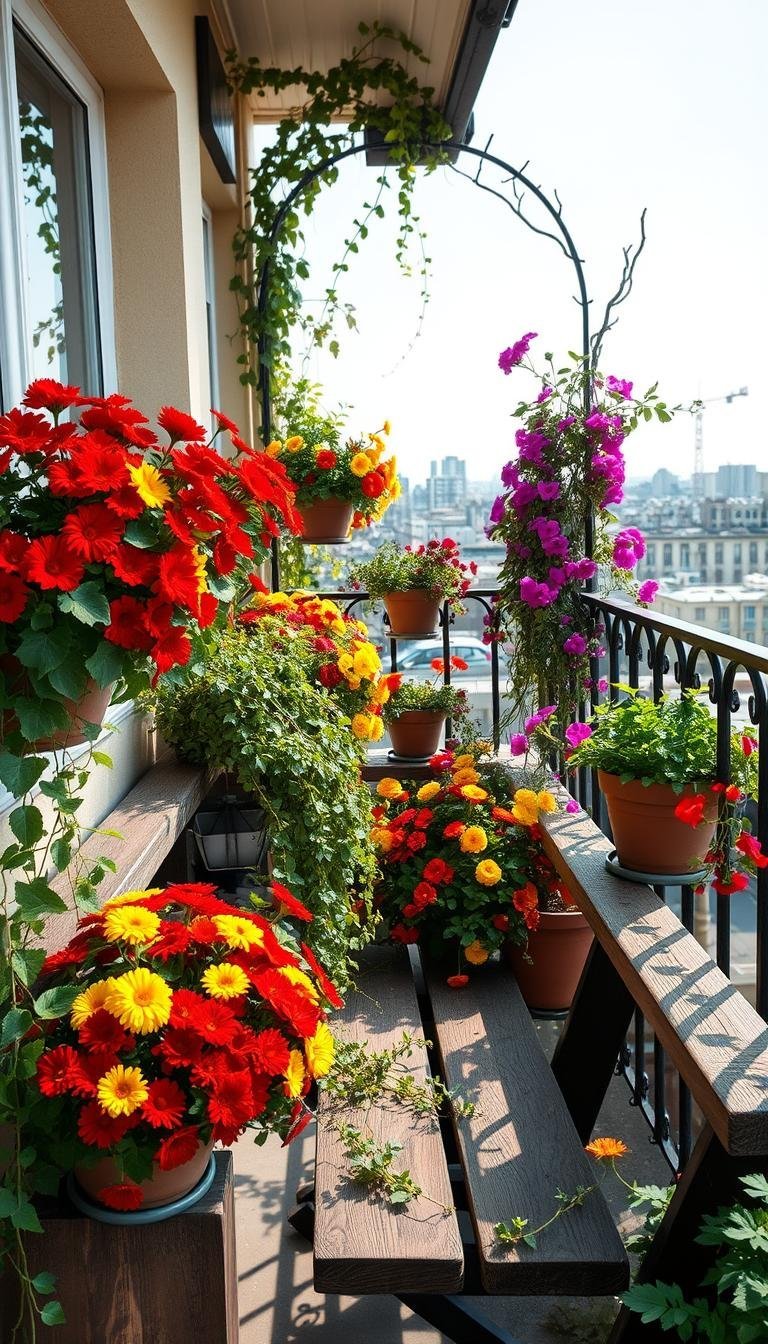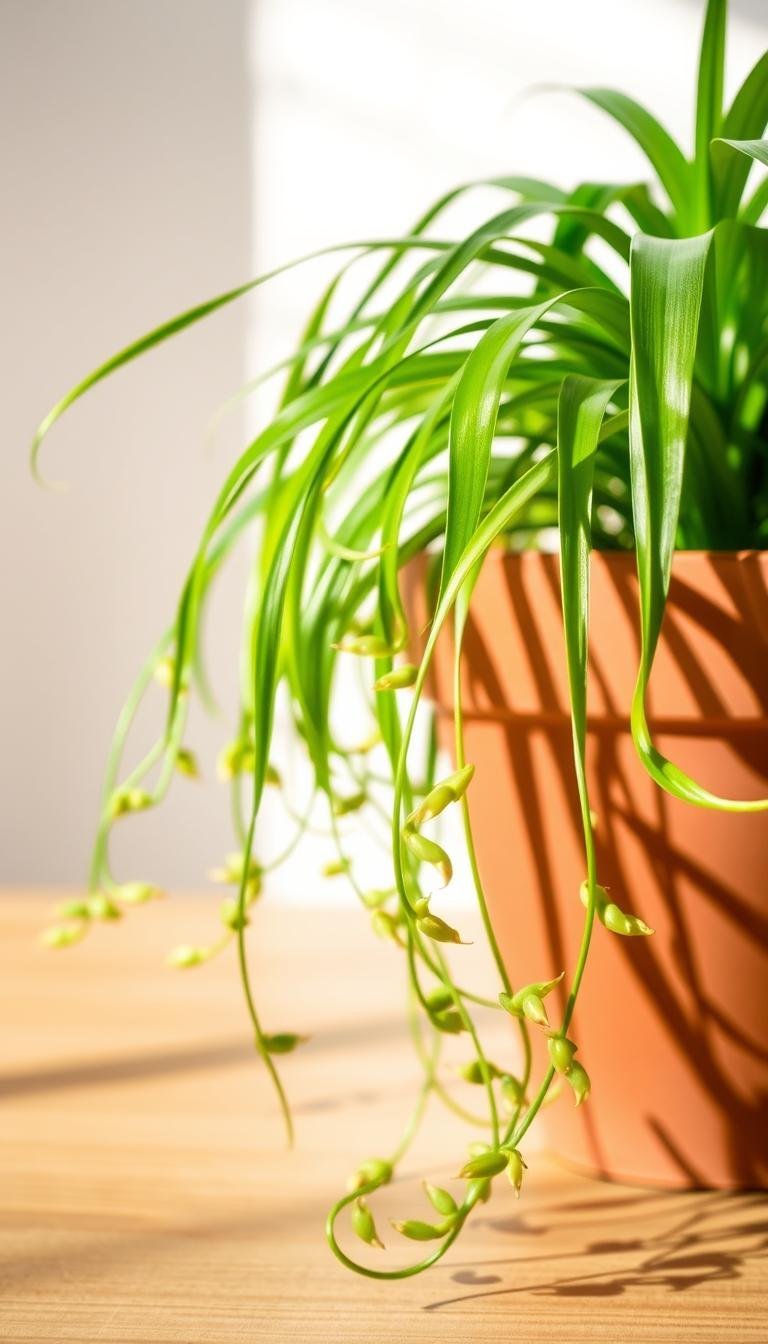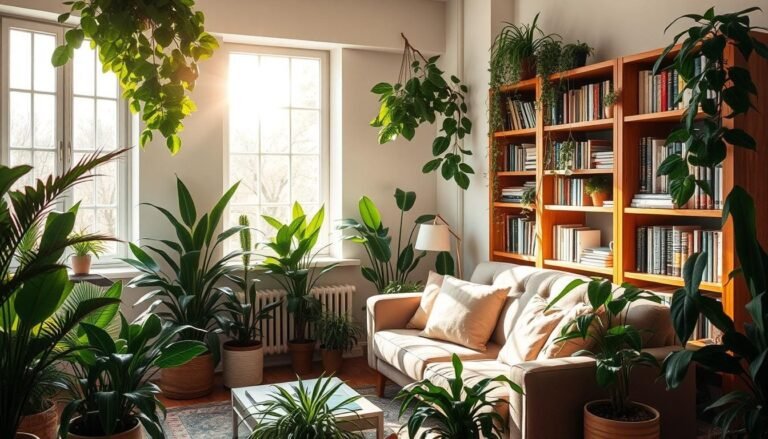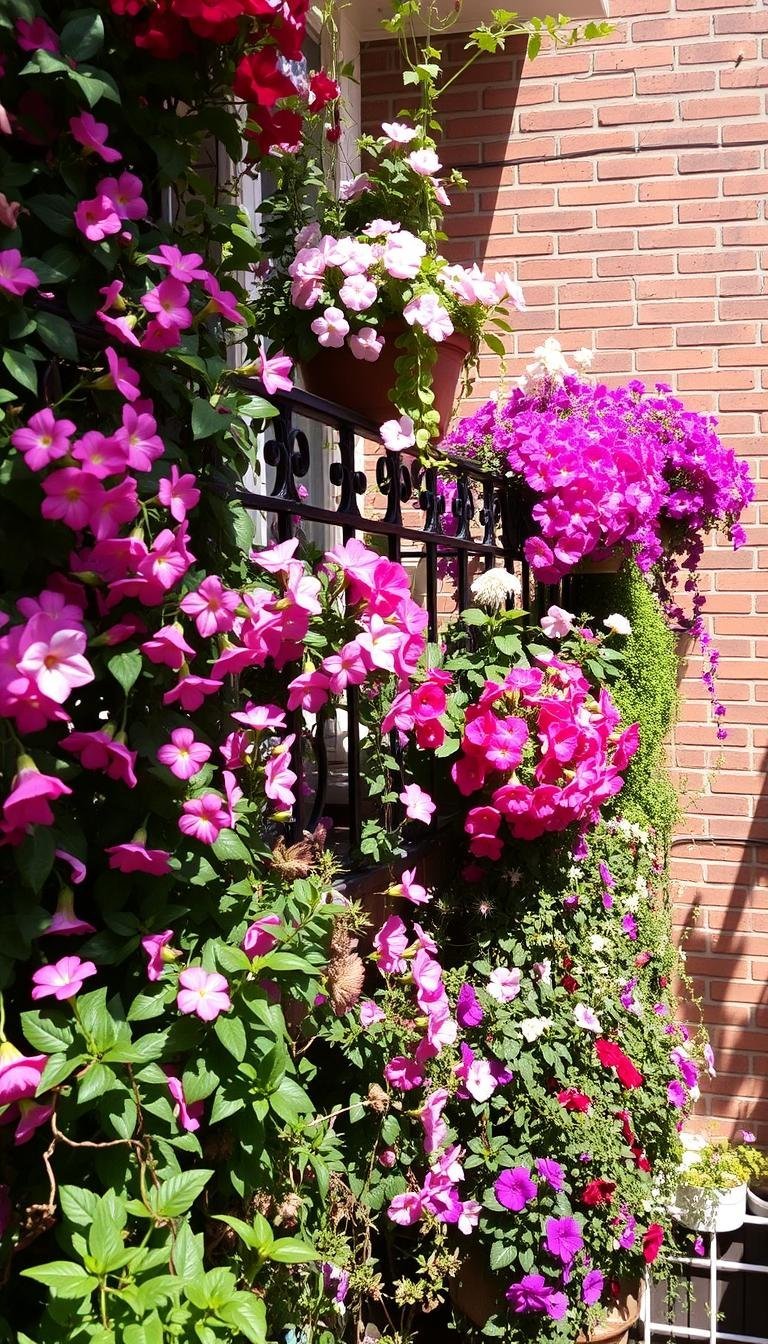This post may contain affiliate links. If you click and buy, we may earn a small commission at no extra cost to you. Learn more.
Even the smallest balcony can become a vibrant garden with the right balcony flowers. Whether you’re a seasoned gardener or just starting, this guide shows how to create a beautiful balcony garden. It uses easy-to-care-for plants and creative layouts.
Imagine stepping onto your balcony to a burst of colors and fresh scents. Balcony flower inspiration doesn’t require a large yard—just smart choices. These spaces boost mood and add curb appeal, making your home feel cozy and inviting.
From sunlit blooms to shade-tolerant varieties, this guide addresses common challenges like space constraints and light limitations. Discover how even urban balconies can thrive with the right plants and techniques.
Contents
- 1 The Best Flowers for Small Spaces
- 2 Selecting the Right Containers
- 3 Maximizing Sunlight Exposure
- 4 Creating a Themed Flower Balcony
- 5 Companion Planting on Your Balcony
- 6 Vertical Gardening Ideas for Limited Space
- 7 Seasonal Care for Balcony Flowers
- 8 Dealing with Pests Naturally
- 9 Bringing Fragrance to Your Balcony
- 10 Budget-Friendly Balcony Flower Ideas
- 11 Tips for Year-Round Flowering
- 12 Inspiration from Designer Balconies
The Best Flowers for Small Spaces
Turn your balcony into a lively garden with plants that grow well in tight spots. Choose from a variety of small balcony flowers to match your style, from modern to cottage. Pick from the best balcony plants list for vibrant colors and easy care.
Choosing the right plants is key for balcony gardening in small spaces. Here are three essential flowers for tight spots:
Petunias: Colorful and Resilient Choices
Petunias are great for containers and window boxes with their flowing blooms. Wave® petunias can spread up to 4 feet, perfect for railings. Make sure to water them regularly but don’t let the soil get too wet. They come in many colors, except true blue, making them a colorful choice for balcony gardens.
Geraniums: A Classic Favorite
Geraniums love the sun and produce lots of flowers in red, pink, or white. ‘Orchid Frost’ hybrids stay small, growing 12-18 inches tall. Remove spent blooms to keep them bushy. They do well in light shade but bloom best with 6+ hours of sunlight.
Marigolds: Easy to Grow and Maintain
Marigolds are perfect for beginners because they grow well in full sun and poor soil. French marigolds only grow 6-12 inches tall. Their strong scent keeps pests like aphids away. Mix them with petunias for a nice contrast in texture.
These flowers are great for even the smallest spaces. Mix different types for a layered look. Check out local garden centers like Home Depot or Walmart for starter plants. With the right light and water, they’ll bloom all spring and fall.
Selecting the Right Containers
Finding the right balcony flower pots or balcony flower boxes begins with knowing your space. Lightweight plastic pots are affordable and don’t crack easily. Terracotta pots breathe well but need more water. Ceramic pots are elegant but heavy, so check your balcony’s weight limits.
Metal containers hold heat, and fabric pots let roots breathe. For balcony garden ideas, think about vertical options like hanging brackets or stackable tiers. These save space.

- Material Matters: Plastic (lightweight), Terracotta (classic), Ceramic (durable), Metal (modern)
- Size Tips: Small pots for tight spots, deep ones for roots
- Style Options: Hanging planters, wall-mounted boxes, or tiered stands
Drainage Solutions for Healthy Roots
Healthy roots need air. Always drill holes for drainage if they’re not there. Use saucers to keep pots off wet surfaces. Add gravel or mesh at the bottom for better air flow.
Self-watering planters with reservoirs are great for avoiding too much water.
Weight and Safety Checks
Heavy pots can harm your balcony. Choose light materials or use strong brackets. Dark pots get hot, so pick light ones for sunny areas. Use small pots for plants with shallow roots to avoid crowding.
Maximizing Sunlight Exposure
Getting the most sunlight is essential for a blooming balcony garden. Begin by tracking the sun’s movement with a timer and notebook. This will show you your balcony’s unique light pattern.
Understanding Your Balcony’s Light Conditions
Knowing your balcony’s light zones is important. Full sun (6+ hours daily) is best for best balcony plants like zinnias. Marigolds prefer partial sun (4-6 hours). Begonias do well in shaded spots (2-4 hours).
Buildings or trees can block light. Move plants to get more sun. Reflective surfaces like aluminum foil can help too.

Rotate your containers weekly for even growth. Don’t overcrowd. Tall plants can cast shadows, so space them out.
Best Flower Options for Different Lighting Situations
- Full Sun: Petunias, zinnias, and sunflowers love bright light.
- Partial Shade: Impatiens and coleus do well in filtered light.
- Full Shade: Fuchsia and asparagus ferns prefer low light.
“Sunlight isn’t just about quantity—it’s about quality. Match plants to their light ‘personality,’ and they’ll reward you,” says urban gardener Maria Lopez.
Adjust your plants as the seasons change. South-facing balconies get a lot of sun. North-facing ones need plants that tolerate shade. Balcony Flowers will bloom better when they get the right amount of light.
Creating a Themed Flower Balcony
Turn your balcony into a special space with balcony flower decoration. You can go for bold contrasts or soft harmonies. Pick a theme to make your garden pop.

Color Schemes: Monochrome vs. Mix
Monochromatic looks are calm and unified. Try different shades of one color, like deep purples with lavender. For a bold look, mix colors like red geraniums with blue delphiniums.
For a soothing look, use colors that are next to each other on the color wheel. For example, pink geraniums with violet stock.
Seasonal Themes for Year-Round Blooms
Change your theme with the seasons for a fresh look. Spring brings soft tulips and pansies. Summer is for bold marigolds and zinnias.
Fall is for vibrant mums and asters. Winter is for hardy violas and evergreen plants. Use evergreens as a base and swap out plants seasonally.
“A well-planned theme turns a balcony into an outdoor room.”
- Monochromatic: Lavender, purple petunias, and silver-leaved dusty miller
- Complementary: Red geraniums with chartreuse sweet potato vines
- Seasonal swap: Replace summer impatiens with cyclamen in fall
Try different themes like a cottage garden or a modern look. Your balcony should show off your style. Every space is unique!
Companion Planting on Your Balcony
Turn your balcony into a lush garden with companion planting. This method pairs plants to help each other grow, saving space and adding beauty. Even tiny flowers can flourish when grouped right. Learn how to mix plants for both function and to attract pollinators.

Pair Flowers with Herbs for Practical Benefits
Try pairing marigolds with basil. Their scent keeps pests away, protecting your herbs. Lavender near roses repels aphids and blends scents. Nasturtiums with herbs add tasty blooms and pest control.
Use tiered containers for small areas. Let herbs grow at the base and flowers climb up.
Attract Pollinators with Strategic Pairings
- Zinnias and cosmos create vibrant clusters that lure butterflies.
- Salvias paired with snapdragons attract bees, boosting pollination.
- Verbena and lantana draw hummingbirds with their nectar-rich blooms.
Place these mixes in sunny spots for the best effect. Pollinators love diverse, colorful spots, even in small areas.
Worried about insects? Most are good—bees and butterflies won’t bother you. Use shallow water dishes to keep them around, not to invade.
Vertical Gardening Ideas for Limited Space
Even the smallest balcony can become a lush garden with vertical solutions. Ideas like trellises, hanging baskets, and wall-mounted planters can increase your growing space by three times. These designs save room, add privacy, and create dynamic layers in your outdoor area.
Start by picking balcony flower boxes that fit perfectly. You can also repurpose items like ladders and shelves for instant vertical charm.

Trellises and Wall Planters to Consider
Choose lightweight metal trellises or wooden frames for walls. For renters, command-hook systems allow you to mount DIY wall planters from recycled gutters or fabric pockets. Train morning glories or thunbergia up these structures—they climb fast and bloom a lot.
Homeowners can install permanent brackets for tiered planters. Fill these with cascading petunias or trailing verbena.
Hanging Baskets: An Elegant Solution
- Choose wire or moss-lined baskets for trailing plants like lymphoma or ivory geraniums.
- Hang baskets at eye level for the best color impact. Make sure brackets are secured with heavy-duty screws to withstand wind.
- Rotate baskets weekly so all sides get sunlight. Water thoroughly until liquid drains from the bottom.
Pair vertical setups with smart balcony flower arrangements. Mix sun-loving blooms at the top and shade-tolerant varieties lower down. These ideas turn narrow spaces into lush, colorful retreats without overwhelming limited square footage.
Seasonal Care for Balcony Flowers
Seasonal care is key for balcony gardening. Adjusting your routine for spring and summer keeps your plants healthy. Here’s how to handle each season:

Spring Planting Tips to Get Started
Begin early for beautiful blooms. Follow these steps:
- Test soil pH and mix in compost for nutrient-rich soil.
- Plant cold-tolerant varieties like pansies in March, then switch to marigolds in April as frost dates pass (check USDA zones 5-8).
- Harden off seedlings by moving them outdoors gradually for 2–3 hours daily before full planting.
Summer Maintenance: Watering and Feeding
Summer’s heat requires careful care:
- Water deeply once a week, adjusting for dry spells. Avoid wetting foliage to prevent mildew.
- Fertilize every two weeks with a 10-10-10 liquid feed diluted to half-strength.
- Deadhead spent blooms weekly to encourage repeat blooming in best balcony plants like petunias.
“Aim to prune leggy stems in morning light for cleaner cuts,” advise urban gardeners.
Keep an eye out for pests by inspecting leaves weekly. Adjust your care based on your climate zone for thriving Balcony Flowers all season.
Dealing with Pests Naturally
Even the most vibrant balcony flower gardening can face pests. Balcony Flowers thrive when gardeners spot issues early. Common invaders like aphids, spider mites, thrips, and whiteflies weaken plants. Their signs include sticky residue, curled leaves, or tiny insects clustered on stems.
Identifying Common Balcony Flower Pests
- Aphids: Soft-bodied insects clustering on new growth, leaving sticky “honeydew.”
- Spider mites: Tiny spiders causing yellow speckles and fine webs on leaves.
- Whiteflies: Small white insects that fly up when plants are disturbed.
Eco-Friendly Pest Control Solutions
Start with prevention: Space plants to allow airflow. Use fine mesh screens to block pests. For outbreaks:
- Mix 1-2 tbsp of mild liquid soap with 1 quart water. Spray affected areas weekly.
- Neem oil diluted with water and a drop of dish soap smothers mites and eggs.
“Ladybugs and lacewings eat aphids. Release these beneficial insects in the evening for best results,” says urban gardener Maria Chen.
Rotate plants weekly to disrupt pest cycles. Avoid chemical sprays that harm neighbors or pets. Focus on balance—some pests are normal, but stay vigilant. A healthy ecosystem starts with the best balcony plants chosen for pest resistance, like marigolds or lavender.
Bringing Fragrance to Your Balcony
Turn your balcony into a sensory paradise with fragrant flowers. Balcony flower inspiration goes beyond just looks. It’s about creating a space that delights all your senses. Whether you want calming scents or uplifting aromas, small flowers can make any spot fragrant.
Best Scented Flowers for Small Areas
Look for compact, fragrant plants that do well in pots. Here are some:
- Lavender: It has a sweet, herb-like smell. It loves sunny spots near where you sit.
- Heliotrope: It smells like vanilla. It blooms from summer to fall and is great near doors.
- Sweet alyssum: It has a light honey scent. It’s perfect for the edges of pots or hanging baskets.
- Night-blooming jasmine: It has a strong sweet smell. It’s perfect for relaxing in the evenings.
Creating a Relaxing Ambiance with Aromas
Design scents that fit your lifestyle. Mix lemon verbena and mint for a morning pick-me-up. Or, blend chamomile with rosemary for a calm evening. For shared spaces, use light scents like stock to avoid bothering others. Try these mixes:
- Evening Oasis: Night-blooming jasmine + moonflower.
- Morning Boost: Lemon thyme + citrus-scented geraniums.
- Stress-Relief Corner: Lavender clusters near seating areas.
Balance scents by spacing plants and rotating containers. This way, you avoid clashing smells. Your balcony can become a personal aromatherapy spot—all in just 10 sq ft or less!
Budget-Friendly Balcony Flower Ideas
Turn your balcony into a garden paradise without spending a lot. Use thrift-store items and household stuff to make beautiful flower pots. Start small, think outside the box, and watch your savings bloom into a colorful garden.
DIY Containers from Common Items
- Repurpose wooden crates as sturdy balcony flower boxes
- Drill drainage holes in tin cans or plastic buckets
- Line old colanders with burlap for cascading plants
- Paint thrifted pots in bold colors for instant style
Old boots or rain boots make fun containers. Just add soil and herbs like basil or thyme.
“The best gardens are born from imagination, not budgets.” – Urban Gardening Collective
Thrifty Plant Picks & Propagation Hacks
Save money by choosing seeds over seedlings. Here are some cheap flowers:
- Marigolds (grow quickly from seed packets)
- Nasturtiums (self-seed freely for year-round blooms)
- Zinnias (available in 50-seed packets at garden centers)
Divide big perennials like hosta in spring. Take cuttings from coleus or sweet potato vine. Root them in water first. Swap seeds with neighbors at community gardens or local plant swaps.
Use these tips to make a stunning balcony garden. Thrift stores, garage sales, and recycling bins are great sources. Every dollar saved lets your creativity—and flowers—thrive.
Tips for Year-Round Flowering
Make your balcony flower gardening last all year with smart choices. Turn your space into a four-season balcony garden ideas hub. Use perennials and winter-ready strategies.
Perennials That Bloom Longer
Choose compact perennials like coreopsis, echinacea, and sedum. These plants do well in containers and bloom again and again. Remember, container-grown plants need a zone hardier than the soil suggests because of colder roots.
Pair them with evergreens or grasses for texture all year.
Winter Prep for Pots and Plants
- Wrap pots with bubble wrap to protect roots
- Group containers together for shared warmth
- Drain soil before freezing to avoid cracking
In milder climates, add winter blooms like hellebores or pansies. For cold areas, use red-twig dogwood stems for winter interest. With these steps, your Balcony Flowers will surprise you with color even in dormancy seasons.
Inspiration from Designer Balconies
Turning your balcony into a lively spot starts with getting inspired. Look at balcony flower arrangement examples from all over the U.S. to get ideas. Designers in big cities like New York and Chicago have made tiny balconies look amazing. They use smart layouts and colors.
They show how to mix looks with function. Let’s see how they do it.
Case Studies: Real-Life Balcony Makeovers
In Denver, Sarah Thompson made her balcony simple yet stylish. She used trailing petunias and TerraCast planters for a modern look. In Miami, Mark Lee mixed tropical plants like hibiscus with hanging baskets for a lush feel.
These designs show that balcony flower decoration is all about matching plants to your taste. Whether you like a cozy cottage look or a city vibe, it’s possible. Designers say picking the right plants means thinking about drainage and light.
Budget-Friendly Design Hacks
You don’t have to spend a lot to get a pro look. Start by using the same flower type, like geraniums in galvanized buckets, for a unified look. Mix bold flowers with simple containers from brands like SimpleModern to save money.
First, focus on the structure, like stands or trellises. Then add seasonal flowers. These tips make balcony flower inspiration easy to follow. Even small changes can make a big difference.
To bring you cozy inspiration more efficiently, we sometimes use AI to assist in content creation — but every word and idea is carefully shaped by our team. See our AI Disclosure for more info.







